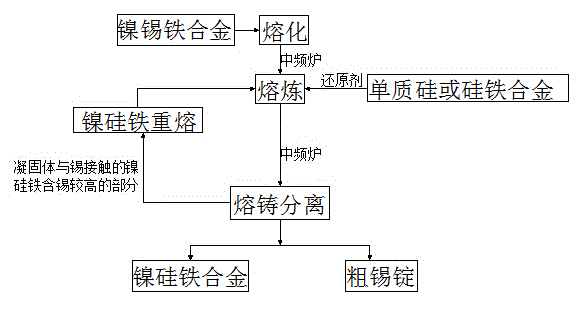Pyrogenic process for separation of tin in nickel-iron alloy scrap
A nickel-iron alloy and separation method technology, applied in the direction of improving process efficiency, can solve the problems of difficult tail gas treatment, easy corrosion of equipment, pollution of the environment, etc., and achieve the effect of low labor intensity, simple and feasible process, and low investment in equipment
- Summary
- Abstract
- Description
- Claims
- Application Information
AI Technical Summary
Problems solved by technology
Method used
Image
Examples
Embodiment 1
[0028] Melting: Put the nickel-iron alloy powder whose main chemical composition is 32% nickel, 56% tin, and 10% iron into the crucible, and the crucible is heated and melted in the muffle furnace, and the temperature is controlled at 1400 degrees to melt all the nickel-tin-iron alloy in the crucible .
[0029] Melting: After the nickel-tin-iron alloy is completely melted, add 75% ferrosilicon to the melt in the crucible according to the nickel-silicon ratio of 2:1 for melting, and at the same time use a lifting shovel to directly add sawdust to the melt surface for protection; the above melting steps can be combined with The melting steps are combined, and the 75 ferrosilicon and nickel-tin-iron alloys are mixed and melted at the same time, and the melting process is also a smelting process.
[0030] Melting and casting separation: keep the smelted melt in the crucible in the muffle furnace for 10 minutes, then lift it out of the intermediate frequency furnace with a crane, h...
Embodiment 2
[0034] Melting: Put the nickel-iron alloy powder whose main chemical composition is 32% nickel, 56% tin, and 10% iron into the crucible, and the crucible is heated and melted in the muffle furnace, and the temperature is controlled at 1500 degrees to melt all the nickel-tin-iron alloy in the crucible .
[0035] Melting: After the nickel-tin-iron alloy is completely melted, 99 silicon is added to the melt in the crucible according to the nickel-silicon ratio of 2:1 for melting, and at the same time, sawdust is directly added to the surface of the melt for protection; the above melting steps can be compared with melting The steps are combined, 99 silicon and nickel-tin-iron alloy are mixed and melted at the same time, and the melting process is also a smelting process.
[0036] Melting and casting separation: keep the smelted melt in the crucible in the muffle furnace for 10 minutes, then lift it out of the intermediate frequency furnace with a crane, hold the crucible with clam...
Embodiment 3
[0040] Melting: Put the nickel-iron alloy powder whose main chemical composition is 32% nickel, 56% tin, and 10% iron into the crucible. The crucible is heated and melted in the intermediate frequency furnace, and the temperature is controlled at 1450 degrees to melt all the nickel-tin-iron alloy in the crucible.
[0041] Melting: After the nickel-tin-iron alloy is completely melted, add 75% ferrosilicon to the melt in the crucible according to the nickel-silicon ratio of 2:1 for melting, and at the same time use a lifting shovel to directly add sawdust to the melt surface for protection; the above melting steps can be combined with The melting steps are combined, and the 75 ferrosilicon and nickel-tin-iron alloys are mixed and melted at the same time, and the melting process is also a smelting process.
[0042] Melting and casting separation: keep the smelted melt in the crucible in the intermediate frequency furnace for 10 minutes, then lift it out of the intermediate frequen...
PUM
 Login to View More
Login to View More Abstract
Description
Claims
Application Information
 Login to View More
Login to View More - R&D
- Intellectual Property
- Life Sciences
- Materials
- Tech Scout
- Unparalleled Data Quality
- Higher Quality Content
- 60% Fewer Hallucinations
Browse by: Latest US Patents, China's latest patents, Technical Efficacy Thesaurus, Application Domain, Technology Topic, Popular Technical Reports.
© 2025 PatSnap. All rights reserved.Legal|Privacy policy|Modern Slavery Act Transparency Statement|Sitemap|About US| Contact US: help@patsnap.com

